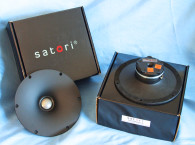
The first transducer to be examined this month came from CLC’s Max Fidelity OEM driver line. A company profile of CLC was featured in Voice Coil’s October 2012 issue. Following this profile, CLC sent two tweeters, the T26AFF5neo BMFF, which was featured in Voice Coil’s December 2012 issue, and the MF2519inv TIneo PRHS, the subject of this review.
This tweeter has an interesting feature set (see Photo 1). Starting with the diaphragm, the MF2519inv TIneo PRHS uses a 25-mm (0.98”) diameter inverted titanium dome with the flat edge of the dome’s outer perimeter serving as the surround, a teardrop shaped phase plug, neodymium motor, and a 19-mm (0.75”) underhung ferrofluid-damped voice coil wound with round copper wire.
This tweeter’s physical features include a press-fit, rubber mounting ring that provides vibration damping between the tweeter and the baffle, a metal screen to protect the dome from prying fingers, a solid-aluminum heatsink, and gold plated terminals. The heatsink performs a couple tasks. First, it seals the relief holes in the back of the motor cup that enable better voice coil seating during assembly (limits magnetic fluid displacement). Second, this heatsink is specifically designed to be directly behind a rear-mounted port for additional cooling. The bullet shape is supposed to minimize turbulence in this location.





To begin testing, I used the LMS analyzer to produce the 300-point impedance sweep (see Figure 1). The magnetic fluid damped resonance is barely detectable at 3.4 kHz. With a 2.73-Ω DCR, the minimum impedance above resonance for this tweeter is 2.8 Ω at 4.7 kHz.
Following the impedance testing, I recess mounted the CLC tweeter in an enclosure that had an 8” × 10” baffle area and measured the on- and off-axis frequency response with a 100-point gated sine wave sweep at 2.83 V/1 m. Figure 2 shows the on-axis response to be ±2.8 dB from 5.2 kHz to 18 kHz (±3.7 dB from 5 kHz to 20 kHz). Figure 3 depicts the MF2519inv TIneo PRHS’s on- and off-axis response, with the off-axis curves normalized to the on-axis response in Figure 4. See Figure 5 for the two-sample SPL comparison, which indicates the two samples were matched within 0.5 to 1 dB throughout the driver’s operating range.
Following the SPL testing procedure, I set up the Listen SoundCheck analyzer and the SC-1.25” microphone to measure the impulse response with the tweeter recess mounted on the test baffle. Importing this data into the Listen SoundMap software produced the cumulative spectral decay “waterfall” plot (see Figure 6).
Figure 7 shows a short-time Fourier transform (STFT) displayed as a surface plot. For the final SoundCheck test, I used a pink noise stimulus to set the 1-m SPL to 94 dB (1.2 V), and measured the second- and third-harmonic distortion at 10 cm (see Figure 8). For more information on this and other CLC drivers, visit www.maxspeakers.com



This article was originally published in Voice Coil, February 2013.







